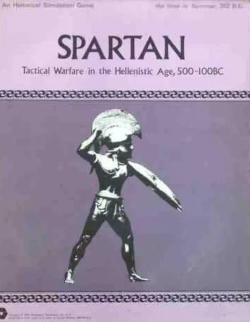
1776, subtitled "The Game of the American Revolutionary War", is a board wargame published by Avalon Hill in 1974 that simulates the American Revolutionary War. Its release was timed to coincide with the bicentenary of the Revolution, and for several years was a bestseller for Avalon Hill.

Patrol, subtitled "Man to Man Combat in the 20th Century", is a skirmish-level board wargame published by Simulations Publications Inc. (SPI) in 1974 as a sequel to Sniper!, which had been released the previous year. Whereas Sniper! was set in urban environments during the Second World War, Patrol is set in a non-urban environment, in various conflicts ranging from 1914 to 1970.

Terrible Swift Sword: Battle of Gettysburg Game is a grand tactical regimental level board wargame published by Simulations Publications, Inc. (SPI) in 1976 that simulates the Battle of Gettysburg during the American Civil War. A second edition was published by TSR in 1986.

Highway to the Reich is a grand tactical monster board wargame published by Simulations Publications, Inc. (SPI) in 1976 that simulates the World War II Allied operation known as Operation Market Garden.

NATO: Operational Combat in Europe in the 1970s is a board wargame published by Simulations Publications Inc. (SPI) in 1973 that simulates an invasion of Western Europe by the Warsaw Pact.

Firefight: Modern U.S. and Soviet Small Unit Tactics is a tactical wargame originally published by Simulations Publications, Inc. (SPI) in 1976 that hypothesizes combat between small units of American and Soviet forces in West Germany in the 1970s.

Wacht am Rhein is a grand tactical monster board wargame published by Simulations Publications, Inc. (SPI) in 1977 that simulates Germany's Battle of the Bulge offensive in late 1944 during World War II.

The American Civil War: 1861–1865 is a board wargame published by Simulations Publications Inc. (SPI) in 1974 that is a strategic simulation of the American Civil War.

The Battle of Borodino: Napoleon in Russia 1812 is a board wargame published by Simulations Publications Inc. (SPI) in 1972 that is a simulation of the Battle of Borodino during the French invasion of Russia in 1812.

The Fast Carriers, subtitled "Air-Sea Operations, 1941–77" is a board wargame published by Simulations Publications Inc. (SPI) in 1975 that simulates naval combat involving aircraft carriers from 1941 to the mid-1970s.

MechWar '77, subtitled "Tactical Armored Combat in the 1970s", is a board wargame published by Simulations Publications Inc. (SPI) in 1975 that simulates hypothetical tank combat in the mid-1970s between various adversaries, using the same rules system as the previously published Panzer '44.

Musket & Pike, subtitled "Tactical Combat, 1550-1680", is a board wargame published by Simulations Publications Inc. (SPI) in 1973 that simulates combat in Europe during the transition from edged weapons to firearms in the 16th and 17th centuries.

Napoleon at Waterloo is a board wargame published by Simulations Publications Inc. (SPI) in 1971 that simulates the Battle of Waterloo. The game, which features simple rules, was designed as an introduction to board wargaming, and was given as a free gift with each subscription to SPI's Strategy & Tactics magazine.

Chariot: Tactical Warfare in the Biblical Age, 3000-500 B.C. is a board wargame published by Simulations Publications Inc. (SPI) in 1975 that simulates various historical battles during the Bronze Age. The game originally started as Armageddon: Tactical Combat, 3000-500 BC, published in 1972, but was revised in order to become the first game in SPI's PRESTAGS collection.

Legion: Tactical Warfare in the Roman Age, 100BC-700AD is a board wargame published by Simulations Publications, Inc. (SPI) in 1975 that simulates battles involving Roman legions against a variety of historical foes. Originally published by SPI as Centurion, the game was revised and republished with the title Legion as part of a series called PRESTAGS.

Spartan: Tactical Warfare in the Hellenistic Age, 500-100BC is a board wargame published by Simulations Publications, Inc. (SPI) in 1975 that simulates battles during the rise of Greece to the period of Roman rule. Originally published by SPI as Phalanx, the game was revised and republished with the title Spartan as part of a series called PRESTAGS.

October War: Doctrine and Tactics in the Yom Kippur Conflict, 1973 is a board wargame published by Simulations Publications, Inc. (SPI) in 1977 that simulates the Yom Kippur War.

PRESTAGS is a collection of five board wargames published by Simulations Publications, Inc. (SPI) in 1975 that simulates battles from the Bronze Age to the Renaissance. The five games were originally published as individual games with their own set of rules before being collected into one box and their various rules revised to produce one common set of rules.

Yeoman, subtitled "Tactical Warfare in the Renaissance Age, 1250-1550", is a board wargame published by Simulations Publications, Inc. (SPI) in 1975 that simulates battles during the Late Medieval period and Renaissance. Originally published by SPI as Renaissance of Infantry, the game was revised and republished with the title Yeoman as part of a collection of games called PRESTAGS.

Sinai: The Arab-Israeli Wars – '56, '67 and '73 is a board wargame published by Simulations Publications Inc. (SPI) in 1973 that simulates three conflicts in the Middle East: The 1956 Suez Crisis, the 1967 Six-Day War, and the just-completed 1973 Yom Kippur War. The staff of SPI had been developing a wargame simulating a hypothetical Middle East conflict when war broke out in October 1973. Using newspaper and television reports, SPI found that their envisioned simulation was not accurate, and quickly redeveloped the game, releasing it only weeks after a ceasefire had been signed. The game proved very popular, and remained a best-seller for SPI during the 1970s.




















